Strategic responses to Performance Measurement in Nonprofit ...
Strategic responses to Performance Measurement in Nonprofit ...
Strategic responses to Performance Measurement in Nonprofit ...
You also want an ePaper? Increase the reach of your titles
YUMPU automatically turns print PDFs into web optimized ePapers that Google loves.
34<br />
<strong>to</strong> the mission or outcome perspective. In such a case a non-profit sec<strong>to</strong>r appropriate balanced<br />
scorecard would be a matter of time.<br />
Secondly, there is a mission drift. The social and non-profits organisations are operat<strong>in</strong>g as<br />
professional service providers <strong>in</strong> a competitive field, where the private sec<strong>to</strong>r logic has<br />
become dom<strong>in</strong>ant under New Public Management. Therefore the omission of a mission or<br />
outcome perspective is a sign that non-profits are becom<strong>in</strong>g more and more similar <strong>to</strong> their<br />
private counterparts. Ashworth et al. call such a process (2000) convergence, i.e. that all<br />
organizations <strong>in</strong> a field resemble each other more closely over time. New Public Management<br />
encourages a market-oriented role model <strong>in</strong> order <strong>to</strong> purge the area from traditional non-profit<br />
<strong>in</strong>efficiencies. That the private sec<strong>to</strong>r model plays a dom<strong>in</strong>ate role is <strong>in</strong> l<strong>in</strong>e with a f<strong>in</strong>d<strong>in</strong>g by<br />
Lakes (1999), who argued, on the basis of an empirical study, that social non-profit<br />
organisations <strong>in</strong>creas<strong>in</strong>gly see their private competi<strong>to</strong>rs as a role model.<br />
Another explanation can be argued by us<strong>in</strong>g <strong>in</strong>stitutional theory (e. g. Scott 1987, Zucker<br />
1987, DiMaggio and Powell 1991) <strong>in</strong> a more classical sense. The majority of the non-profit<br />
organisations <strong>in</strong>terviewed use the balanced scorecard because it is regarded as a modern<br />
management <strong>to</strong>ol, help<strong>in</strong>g <strong>to</strong> create legitimacy (Greil<strong>in</strong>g 2010). The balanced scorecard<br />
design is then an example of mimetic isomorphism (DiMaggio and Powell 1987) and is used<br />
<strong>in</strong> a loosely-coupled or decoupled way (Scott and Meyer 1991, Law<strong>to</strong>n et al. 2000, Greil<strong>in</strong>g<br />
2010). With Scherm and Pietsch (2005) one can argue that the balanced scorecard may serve<br />
a double function: Firstly, it helps <strong>to</strong> signal <strong>to</strong> the funders that the management of a non-profit<br />
organisation is up-<strong>to</strong>-date with modern management <strong>to</strong>ols. Secondly, it may also add <strong>to</strong> the<br />
legitimacy of the key funders because they can communicate <strong>to</strong> their own key stakeholders<br />
that they have supported organisations which subscribe <strong>to</strong> an efficient and effective<br />
management practices. As a caveat it has <strong>to</strong> be mentioned that with a sample of only 20 non-<br />
profit organisations it is not a clear-cut decision which explanations carry most weight.
















